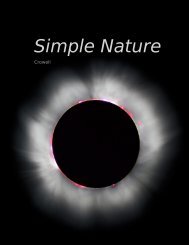The size of a radio antenna is closely related to ... - Light and Matter
The size of a radio antenna is closely related to ... - Light and Matter
The size of a radio antenna is closely related to ... - Light and Matter
Create successful ePaper yourself
Turn your PDF publications into a flip-book with our unique Google optimized e-Paper software.
An easy way <strong>to</strong> v<strong>is</strong>ualize th<strong>is</strong> <strong>is</strong> in terms <strong>of</strong> a strip chart recorder,<br />
an obsolescing device cons<strong>is</strong>ting <strong>of</strong> a pen that wiggles back <strong>and</strong> forth<br />
as a roll <strong>of</strong> paper <strong>is</strong> fed under it. It can be used <strong>to</strong> record a person’s<br />
electrocardiogram, or se<strong>is</strong>mic waves <strong>to</strong>o small <strong>to</strong> be felt as a<br />
noticeable earthquake but detectable by a se<strong>is</strong>mometer. Taking the<br />
se<strong>is</strong>mometer as an example, the chart <strong>is</strong> essentially a record <strong>of</strong> the<br />
ground’s wave motion as a function <strong>of</strong> time, but if the paper was set<br />
<strong>to</strong> feed at the same velocity as the motion <strong>of</strong> an earthquake wave, it<br />
would also be a full-scale representation <strong>of</strong> the pr<strong>of</strong>ile <strong>of</strong> the actual<br />
wave pattern itself. Assuming, as <strong>is</strong> usually the case, that the wave<br />
velocity <strong>is</strong> a constant number regardless <strong>of</strong> the wave’s shape, knowing<br />
the wave motion as a function <strong>of</strong> time <strong>is</strong> equivalent <strong>to</strong> knowing<br />
it as a function <strong>of</strong> position.<br />
Wavelength<br />
Any wave that <strong>is</strong> periodic will also d<strong>is</strong>play a repeating pattern<br />
when graphed as a function <strong>of</strong> position. <strong>The</strong> d<strong>is</strong>tance spanned by<br />
one repetition <strong>is</strong> referred <strong>to</strong> as one wavelength. <strong>The</strong> usual notation<br />
for wavelength <strong>is</strong> λ, the Greek letter lambda. Wavelength <strong>is</strong> <strong>to</strong> space<br />
as period <strong>is</strong> <strong>to</strong> time.<br />
Wave velocity <strong>related</strong> <strong>to</strong> frequency <strong>and</strong> wavelength<br />
Suppose that we create a repetitive d<strong>is</strong>turbance by kicking the<br />
surface <strong>of</strong> a swimming pool. We are essentially making a series <strong>of</strong><br />
wave pulses. <strong>The</strong> wavelength <strong>is</strong> simply the d<strong>is</strong>tance a pulse <strong>is</strong> able <strong>to</strong><br />
travel before we make the next pulse. <strong>The</strong> d<strong>is</strong>tance between pulses<br />
<strong>is</strong> λ, <strong>and</strong> the time between pulses <strong>is</strong> the period, T , so the speed <strong>of</strong><br />
the wave <strong>is</strong> the d<strong>is</strong>tance divided by the time,<br />
v = λ/T .<br />
Th<strong>is</strong> important <strong>and</strong> useful relationship <strong>is</strong> more commonly written<br />
in terms <strong>of</strong> the frequency,<br />
v = fλ .<br />
Wavelength <strong>of</strong> <strong>radio</strong> waves example 5<br />
⊲ <strong>The</strong> speed <strong>of</strong> light <strong>is</strong> 3.0 × 10 8 m/s. What <strong>is</strong> the wavelength <strong>of</strong><br />
the <strong>radio</strong> waves emitted by KMHD, a station whose frequency <strong>is</strong><br />
89.1 MHz?<br />
⊲ Solving for wavelength, we have<br />
s / Wavelengths <strong>of</strong> linear <strong>and</strong><br />
circular waves.<br />
λ = v/f<br />
= (3.0 × 10 8 m/s) /(89.1 × 10 6 s −1 )<br />
= 3.4 m<br />
352 Chapter 6 Waves














